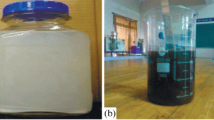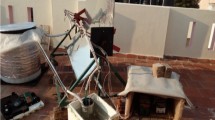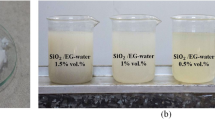Abstract
Energy demand keeps growing all over the world and is contributing to climate change. So, fossil fuels must be replaced by renewable energies. Solar energy is the most accessible energy in Iran as well as in many other countries. Parabolic solar collectors appear to be a very promising technology in solar energy absorption. Meanwhile, nano-fluids are known to improve the heat transfer capabilities in comparison with ordinary pure fluids. In this work, an experimental study was applied to solar collectors using water/Al2O3 nano-fluid located in a renewable energy site of Islamic Azad university of Khomenishahr branch followed by numerical simulations. Experimental tests were conducted for 2, 3, and 4 L·min−1 flow rates with pure water and 0.1 %, 0.2 %, and 0.3 % volume fraction of nanoparticles, respectively, with the results validating the numerical simulations. The results revealed that reductions in flow rate and elevations in volume fraction led to increased outlet temperature of solar collector, inlet and outlet temperature difference in collector, tank and radiator, and improved solar collector efficiency. Also, heat transfer coefficient rose with augmenting the flow rate and volume fraction.

















Similar content being viewed by others
Abbreviations
- A:
-
Surface area (m2)
- \(Q\) :
-
Heat transfer (J)
- \(D\) :
-
Diameter (m)
- \(I\) :
-
Incidence solar flux (w·m−2)
- Re :
-
Reynolds number
- \(S_{m}\) :
-
Energy generation (w·m−3)
- \(U\) :
-
Velocity vector
- \(T\) :
-
Temperature (\(^\circ C\))
- \(f\) :
-
Friction factor
- \(g\) :
-
Gravity (m·s−2)
- \(h\) :
-
Heat transfer coefficient (w·m−2·k−1)
- \(n\) :
-
Refraction coefficient
- \(P\) :
-
Pressure (Pa)
- \(Pr\) :
-
Prandtl number
- \(c_{p}\) :
-
Specific heat (J·kg−1·k−1)
- \(r\) :
-
Position vector
- \(s\) :
-
Path duration
- \(\vec{s}\) :
-
Direction vector
- \(s^{\prime}\) :
-
Distribution direction vector
- \(u_{y}\) :
-
Velocity component y direction (m·s−1)
- \(u_{x}\) :
-
Velocity component x direction (m·s−1)
- \(t\) :
-
Time (s)
- \(in\) :
-
Inlet parameters
- \(out\) :
-
Outlet parameters
- \(np\) :
-
Nanoparticle
- \(bf\) :
-
Base fluid
- \(Q^{,}\) :
-
State function
- \(\tau\) :
-
Stress tensor
- \(\alpha\) :
-
Absorption coefficient
- \(\sigma\) :
-
Stefan–Boltzmann constant 5.670 367 × 10−8 (kg·s−3·k−4)
- \(\sigma_{s}\) :
-
Scattering coefficient
- \(\rho\) :
-
Density (kg·m−3)
- \(\eta\) :
-
Collector efficiency
- \(\varOmega\) :
-
Solid angel
- \(\mu\) :
-
Dynamic viscosity (kg·m−1·s−1)
References
Z. Cheng, Y. He, F. Cu, R.J. Xu, Y.B. Tao, Numerical simulation of a parabolic trough solar collector with nonuniform solar flux conditions by coupling FVM and MCRT method. Sol. Energy 86, 1770–1784 (2012)
P. Alamdari, O. Nematollahi, A. Alemrajabi, Solar energy potentials in Iran: a review. Renew. Sustain. Energy Rev. 21, 778–788 (2013)
G. Coccia, G. Di Nicola, L. Colla, L. Fedele, M. Scattoloni, Adoption of Nano fluids in low-enthalpy parabolic trough solar collectors: numerical simulation of the yearly yield. Energy Convers. Manage. 118, 306–319 (2016)
H. Tyagi, P. Phelan, R. Prasher, Predicted efficiency of a low-temperature Nanofluid-based direct absorption solar collector. J. Sol. Energy Eng. 131, 4 (2009)
Q. He, S. Wang, Z. Zheng, Experimental investigation on photo thermal properties of Nanofluids for direct absorption solar thermal energy systems ̏. Energy Convers. Manage. 73, 150–157 (2013)
M. Karami, B. Akhavan, S. Delfani, M. Raisee, Experimental investigation of CuO Nanofluid-based direct absorption solar collector for residential applications. Renew. Sustain. Energy Rev. 52, 793–801 (2015)
T. Yousefi, F. Veysi, E. Shojaeezade, S. Zinadini, An experimental investigation on the effect of Al2O3–H2O Nanofluid on the efficiency of flat-plate solar collectors. Renew. Energy 39, 293–298 (2012)
Q. He, S.H. Zeng, S. Wang, Experimental investigation on the efficiency of flat-plate solar collectors with Nanofluid. Appl. Therm. Eng. 88, 165–171 (2015)
N. Sint, I. Choulhury, H. Masjuki, H. Aoyama, Theoretical analysis to determine the efficiency of a CuO-water Nanofluid based-flat plate solar collector for domestic solar water heating system in Myanmar. Sol. Energy 155, 608–619 (2017)
J. Ghaderian, N. Sidik, An experimental investigation on the effect of Al2O3/distilled water Nanofluid on the energy efficiency of evacuated tube solar collector. Int. J. Heat Mass Transf. 108, 972–987 (2017)
E. Ghasemi, A. Ranjbar, Thermal performance analysis of solar parabolic trough collector using Nanofluid as working fluid: a CFD modeling study. J. Mol. Liq. 222, 159–166 (2016)
A. Mwesigye, Z.H. Meyerd, Thermal and thermodynamic performance of a parabolic trough receiver with Syltherm800-Al2O3Nanofluid as the heat transfer fluid. Energy Procedia 75, 394–402 (2015)
A. Kasaeian, S. Paviran, R. Azarian, A. Rashidi, Performance evaluation and Nanofluid using capability study of a solar parabolic trough collector. Energy Convers. Manage. 89, 368–375 (2015)
P. Zadeh, M.T. Sokhansefat, A. Kasaeian, F. Kovsay, A. Akbarzade, Hybrid optimization algorithm for thermal analysis in a solar parabolic trough collector based on Nanofluid. Energy 82, 857–864 (2015)
Y. Wang, Q. Liu, J. Lei, H. Jin, Performance analysis of a parabolic trough solar collector with non-uniform solar flux conditions. Int. J. Heat Mass Transf. 82, 236–249 (2015)
A. Menbari, A. Alemrajabi, A. Rezaei, Heat transfer analysis and the effect of CuO/Water Nanofluid on direct absorption concentrating solar collector. Appl. Therm. Eng. 104, 176–183 (2016)
Fluent Release 14.0, User̕s guide, Fluent In C, 2016
Z. Cheng, Y. He, J. Xiao, Y. Tao, R. Xu, Three-dimensional numerical study of heat transfer characteristics in the receiver tube of parabolic trough solar collector. Int. Commun. Heat Mass Transfer 37, 782–787 (2010)
E. Bellos, C. Tivanidis, G. Gkinis, Thermal enhancement of solar parabolic trough collectors by using Nanofluids and converging-diverging absorber tube. Renew Energy 94, 213–222 (2016)
Author information
Authors and Affiliations
Corresponding author
Additional information
Publisher's Note
Springer Nature remains neutral with regard to jurisdictional claims in published maps and institutional affiliations.
Rights and permissions
About this article
Cite this article
Nayerdinzadeh, S., Babadi Soultanzadeh, M., Haratian, M. et al. Experimental and Numerical Evaluation of Thermal Performance of Parabolic Solar Collector Using Water/Al2O3 Nano-fluid: A Case Study. Int J Thermophys 41, 59 (2020). https://doi.org/10.1007/s10765-020-02638-3
Received:
Accepted:
Published:
DOI: https://doi.org/10.1007/s10765-020-02638-3




